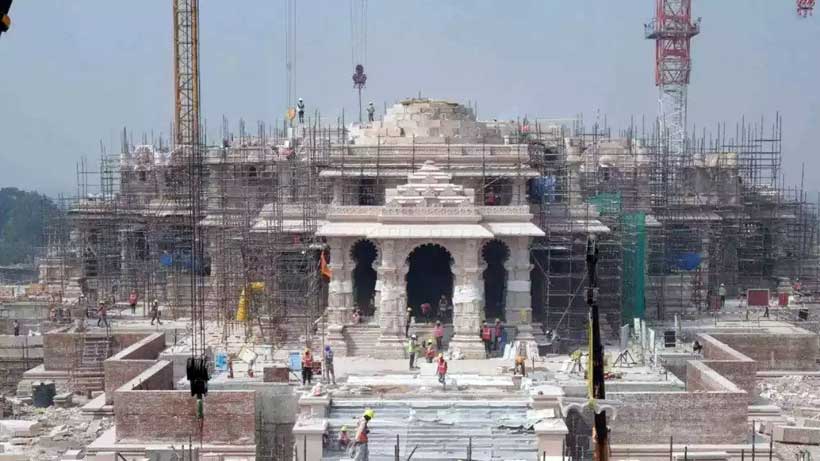Biased headlines and false narratives, however, have dominated Western mainstream media, who meticulously ignore the historical context in which the temple was restored.
Most Western media outlets focused on how the temple was built on the site of a mosque. They falsely portrayed its inauguration as “a violation against Muslims”. Yet, they hide or ignore a significant fact: Centuries ago, invading Islamic jihadis (namely, the Mughal Empire) destroyed the original Hindu temple which had been built on the land.
This is proven by archeological evidence which includes historical accounts as well as the 2019 ruling of India’s Supreme Court. Yet, lies, half-truths and misguided attacks against the Indian government and Hindu people are prevalent in mainstream media.
A brief historical background might help.
Islamic armies started targeting India in the seventh century. Muslim invaders established the Delhi sultanate in the 13th century and the Mughal dynasty in the 16th century.
The Mughal Empire occupied India from the early 16th to the mid-18th century, during which time they destroyed the temple. Instead, they built a mosque on top as a show of Islamic supremacy and a political statement of domination.
Under Muslim rule, Hindus were subject to severe persecution which included forced conversions, sexual slavery, massacres, demolition of temples, and educational centers, as well as oppressive taxation levied on non-Muslims.
As Koenraad Elst, the author of many books and articles regarding Hindus, wrote:
“Islamic rule in India as a ‘colonial experiment’ was ‘extremely violent’, and ‘the Muslims could not rule the country except by systematic terror. Cruelty was the norm — burnings, summary executions, crucifixions or impalements, inventive tortures. Hindu temples were destroyed to make way for mosques. On occasion there were forced conversions. If ever there were an uprising, it was instantly and savagely repressed: houses were burned, the countryside was laid waste, men were slaughtered, and women were taken as slaves.’
“Apart from actual killing, millions of Hindus disappeared by way of enslavement. After every conquest by a Muslim invader, slave markets in Bagdad and Samarkand were flooded with Hindus. Slaves were likely to die of hardship, e.g. the mountain range Hindu Koh, ‘Indian mountain’, was renamed Hindu Kush, ‘Hindu-killer’, when one cold night in the reign of Timur Lenk (1398-99), a hundred thousand Hindu slaves died there while on transport to Central Asia. Though Timur conquered Delhi from another Muslim ruler, he recorded in his journal that he made sure his pillaging soldiers spared the Muslim quarter, while in the Hindu areas, they took ‘twenty slaves each’. Hindu slaves were converted to Islam, and when their descendants gained their freedom, they swelled the numbers of the Muslim community.”
The Ram Temple is one of the thousands destroyed by Muslim invaders of India.
Western mainstream media, however, falsely call the inauguration of the temple as a show of “Hindu supremacy”. The truth is the complete opposite. The inauguration of this historic temple is all about restorative justice and decolonization.
As Dr. Lindsey Pointer, the Associate Director of National Center on Restorative Justice, notes, “Restorative justice conceives of justice as ‘repair’ to the harm caused by crime and conflict.”
Author Sankrant Sanu adds: “Places of worship destroyed by force by tyrants, as [the Mughal emperor] Babur destroyed Ram Mandir, get reclaimed when one gets free of the invader. In India, this did not take place as a violent process of Reconquista but as a systematic evidence-based process where the Supreme Court of India weighed all the evidence for the pre-existing temple and restored the land to Hindus.”
According to a report by the Council of Europe,
“The cultural agency of the material heritage often depends on its legibility which may be undermined due to past alterations, damage and deterioration. Restoration is a complex ensemble of actions which can include the integration and replacement of non-original elements, reconstruction, retouching and infilling. It is aimed at facilitating the appreciation, understanding and utilisation of cultural heritage.”
On the legal front, it took approximately 30 years to receive approval from India’s Supreme Court for Hindus to reclaim and restore the temple.
In 2019, the Supreme Court of India said that there used to be a Hindu temple beneath the mosque. It also ruled that a Hindu temple would be built on the land and a parcel of land provided to the Muslims for the construction of a new mosque.
Accordingly, the construction of a grand mosque in Ayodhya will begin in May of this year, a senior official of the Indo-Islamic Cultural Foundation told Reuters. It is likely to take three to four years to complete.
Nevertheless, some Muslims resorted to violence ahead of, during and in the aftermath of the inauguration. Muslim violence of varying scales was reported within different parts of India as PM Modi presided over the consecration ceremony of the temple.
Despite all the Western media bashing and physical attacks by Muslims, one fact remains unchanged: The significance of this temple for Hindus is the same as Jerusalem for Jews, Mecca for Muslims, and the Vatican for Catholics.
“[The deity] Rama is a very significant cultural and religious icon not only for India and Hindus, but for all Southeast Asia,” Sanu adds. “The Kings of Thailand are still named King Rama after him, and Indonesia has a major cultural opera based on the story of Rama, the Ramayana. The restoration of the temple at his birthplace is a momentous occasion for indigenous rights around the globe. That this event of reparations was done with relative harmony and with mutuality can be a model throughout the world. Justice and truth can prevail even after 500 years after a tyrant’s act.”
January 22 was thus a truly historic day for India’s cultural heritage, as well as the religious liberty and restorative justice for Hindu people who are now free from invaders and colonizers.
